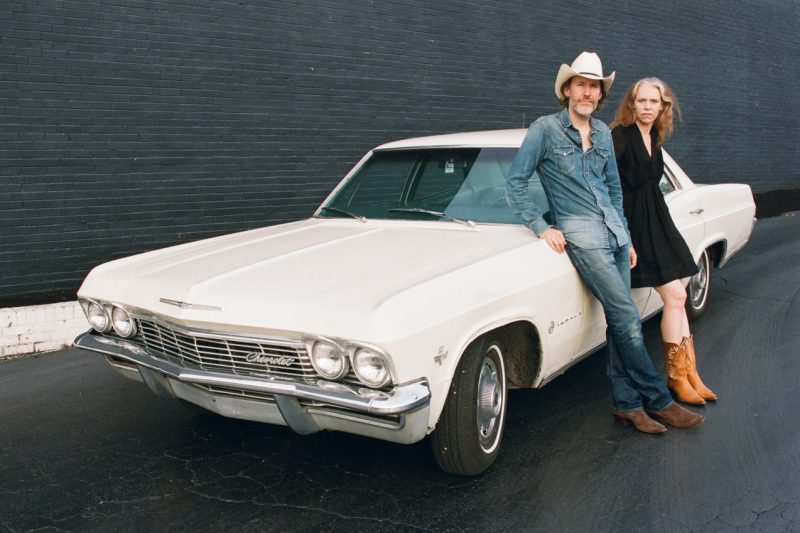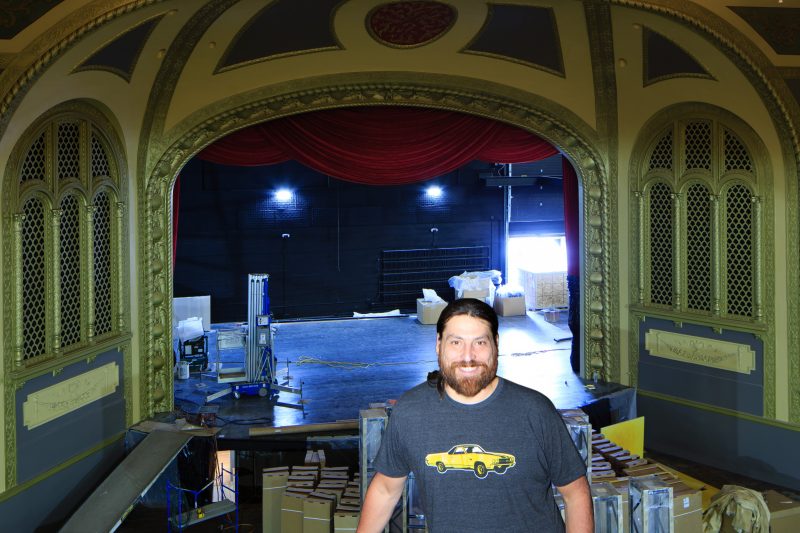Missoula was smoky and electric the morning I interviewed Nick Checota at the Top Hat Lounge. He was realigning tables for that night’s Lil’ Smokies show.
“It‘s gonna be crazy in here,” he predicted.
Checota – friendly, fast-talking, intense – and his wife, Robin, bought the Top Hat – a fabled but decrepit Missoula bar – in 2013, and transformed it into a hip club that now brings in some of the hottest and most eclectic shows in the state, from Lucinda Williams and Trombone Shorty to the psychedelic jazz-funk band Lettuce.
“This is not work,” says the former real estate developer. “I love it. It’s fun.”
Last spring, the Checotas purchased another revered venue, the Wilma, and began the delicate and expensive task of restoring and renovating the grand old theatre.
When it opened in 1921, the Wilma was billed as the “finest place of its sort between the Twin Cities and the Pacific Coast.”
Checota hopes to restore that reputation.
As we walk down Front Street and around the corner to his new venue, Checota says, “This is definitely the most interesting piece of real estate I’ve ever owned.”
“Like my wife pointed out, it’s not like we own it. The community owns it. We’re just the caretakers.” Even during construction, he adds, “people would just walk in to see what we’re doing.”
The Wilma was built in 1921 by Billy Simons, and named for his wife, light opera vaudeville star Edna Wilma. Its acoustics were designed so its namesake could sing on stage and be heard clearly at the back of the hall.
We witnessed that superb sound in 2011, when Dave Rawlings and Gillian Welch (who return to the Wilma stage this month), shushed the crowd, turned off the amplifiers and played an acoustic version of “Long Black Veil” to the packed house. We heard every word.
But for most contemporary bands, that kind of articulation isn’t a boon. “It’s an old vaudeville house, with acoustics built into the room,” Checota says. But with contemporary sound systems “You don’t want that.”
First stop, the Top Hat
The Top Hat was Checota’s first venture as a nightclub owner and music promoter. He grew up in Wisconsin, and earned an undergraduate degree in business economics at Bentley University in Boston. That’s where he met Robin, a native of Great Falls, who was the RA in his dorm. They were married 20 years ago in Montana.
Nick worked in the financial services industry before earning an MBA from Vanderbilt University in Nashville. He eventually went to work for the family business, Landmark Healthcare Facilities, which designs, develops and constructs healthcare buildings and leases them to hospitals and medical groups.
But incessant travel and time demands took a toll on his family life. After 12 years, he sold his share in the business and the family moved to Missoula, where Robin’s two sisters have lived since the 1970s.
The couple has three children, and regards Missoula as “a perfect place to raise kids,” with its mix of small-town ambiance with cultural amenities.
Initially, the Checotas purchased the Army-Navy Building, remodeled it, and sold it to Plonk, a high-end wine and cocktail bar. When the Top Hat came on the market in 2012, “I thought it was a cool opportunity to do something different.”
Nonetheless, Checota found it a “huge jump” from real-estate development and overseeing a crew of engineers and designers to running a bar and restaurant and booking his own music.
It helps though, that he’s a “huge music fan. Always have been.”
He’s also very engaged in every aspect of his business, from the music, to the menu, to organizing the seating for the evening’s show, and making sure the artists “are wined and dined.”
“The artists and agents are as important to us as the concert-goers,” he says. “Unlike all the huge production companies, the owner is here, and cares about the artist’s experience. They like that.”
As the venue owner and music promoter, Checota can also afford to be “more risk-assumptive” than many promoters. Trombone Shorty, for example, cost $15,000 to bring to town, with $7,000 up front. “A local promoter often has no capital. If it’s a risk or a huge outlay, they won’t do it.”
But Checota makes money on more than ticket sales. “I need to break even or close on the artist, but I also have the bar and food – and I own the space.”
That combination allows him to bring more diverse regional and national acts to town. “Missoula was ripe for this,” he says. “They like good, cutting-edge music and they support it.”
Proof: 12 of his 15 shows in August sold out.
Historic and hip
The Wilma allows him to put that model to work on a larger scale. The Top Hat is maxed out at 600 for a standing-room-only show. The Wilma can accommodate 1,400, which will allow Checota to negotiate with larger national and international acts that are traveling from Seattle to Salt Lake, or from Portland to Minneapolis.
My Morning Jacket, the Wilma’s first show under the Checotas’ reign, sold out immediately. The band arrives for the Oct. 5 show with four semi-loads of equipment, and crews were feverishly at work this summer – putting in 14-hour shifts, six days a week – to make sure the Wilma would be ready.
Checota estimates that he’s spent $2.5 million (beyond the undisclosed purchase price) on transforming a vaudeville-era showplace into a 21st century concert hall, with the grace and ambiance of that earlier era intact.
When they first bought the Wilma, Checota attended an EDM show in the old theatre. “It was 91 degrees during the show,” he reports. “There’s was no airflow – the sweat and smoke were thick.”
The electrical and mechanical infrastructure (including the wiring my grandfather installed in the 20s) was completely redone, with new heating, cooling, and plumbing. A 12-speaker sound system by L-Acoustics hangs on each side of the stage, and fabric-covered panels were installed to improve the room’s sound quality.
The concrete floor was replaced with hardwood – “it just looks better, aesthetically” – and is tiered instead of slanted. The stage was raised 22 inches, with special attention given to the view lines from each tier and the balcony. A mobile seating system allows for cabaret-style tables and chairs, rows of theater seats, or no chairs at all on the main floor for standing-room-only shows.
“Missoula was starved for a multi-use private events space,” says Checota. He envisions wedding receptions and banquets beneath the Art Deco chandeliers.
The balcony has fixed seats and a bar replaces the screening room. The theater will still show select movies and film festivals, but in the digital age, “you don’t need a room for that anymore.”
A catering kitchen was added, and the Checotas secured a full liquor license from Harold’s Club in Milltown. The back wall was bumped out, so that two bars and the stairways to the balcony are now inside the theater.
The small movie theater at the front will serve as a lounge area for VIP meet-and-greet or small parties. The grungy green room below the stage (rumored to be haunted), was completely gutted and replaced with elegant quarters for the headliner, equipped with a bathroom, shower, and dining area. Two offices were added, one for tour managers and another for local production staff; and the tour crew has its own area, also equipped with a bathroom and shower.
Motorized steel trusses were installed back stage to handle more complex lighting and sets. The pipe organ is in storage, waiting for a buyer.
He and his wife spent countless hours before renovations started considering the color palette (every generation added its own layer of paint) and decided on a simple blue-gray and yellow theme. The original ceiling murals were touched up by Missoula artist Amanda Biebly; and instead of covering the walls with sheetrock, they decided to restore the plaster.
In preparation for the project, which began in June, Checota also toured around 20 of the top-tier theaters in the country. “Every venue did something well, but none were perfect.”
By comparison, he says, “the character of this room is awesome.” And the new equipment promises to deliver “fantastic sound.”
“This theatre was an amazing thing. It was designed just perfectly in so many ways,” says Checota. “When it’s done, it’s going to be one of the top-tier houses in the country.”
Open House on First Friday
The public is welcome to walk through The Wilma during an open house on First Friday, Oct. 2. The Whizpops and Lil’ Smokies will try out the new stage and sound system – a precursor to the eight shows already lined up for the coming month. A Warren Miller ski film and a benefit for children who lost parents in a fatal shooting are also on the schedule. The latter is part of the Checotas’ ongoing commitment to make the Top Hat, and now the Wilma, available to the community.
“My philosophy is make the right investment, do it right, and you’ll recover your investment,” says Nick.
For those us who have witnessed the Wilma’s steady decline over the past several decades, the Checotas’ pledge to thoughtfully, carefully bringing her back to life goes beyond a sound investment. It’s a gift to Missoula and the region.
– Kristi Niemeyer


